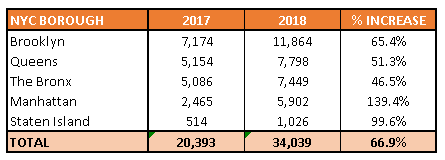2024 Outlook for Residential Construction in New York City

The NYC construction industry had an excellent year in 2018, and the development boom is expected to continue through 2019. A gradual slowdown is expected as more housing units reach the market, but recent project filings with the NYC Department of Buildings indicate that 2019 will also be a very active year.
Of course, there are important challenges to overcome even in the middle of a construction boom. Improved safety for construction workers is a high priority - although 2018 was an excellent year in terms of growth, it has also been the year with the most construction accidents in over a decade. Managing construction costs will also be a challenge, since new tariffs on imported materials are driving up their prices.
Optimize the construction process of your next project.
What happened in NYC Housing Market in 2019?
In 2019, New York City had no shortage of apartments, as more than 28,000 new units reached the housing market.
- Brooklyn took the lead, with more than 13,200 new apartments in 421 buildings.
- Manhattan and Queens also experienced significant growth, with more than 6,300 new apartments opening in each borough. These apartments were distributed among 79 buildings in Manhattan and 154 buildings in Queens.
- The Bronx had over 2,400 new apartments.
- The smallest growth was expected in Staten Island, with 126 new apartments.
Most of the residential construction activity is concentrated in luxury towers, which leads to lucrative but slow sales. The expected timeframe to sell the new developments in Manhattan is around six years - homes with an asking price of $4 million are taking nearly 450 days in the market.

When considering the new units filed with the NYC Department of Buildings in 2018, growth figures are even more impressive.
- The NYC DOB reports 34,039 housing units filed in 2018, a 67% increase compared with the 20,393 units filed in 2017.
- The multi-family sector leads growth, with 32,580 units filed in 2018. This is a 70% increase with respect to the 19,180 units filed in 2017.
- The 34,039 new units filed correspond to 2,482 buildings, and this includes one- and two-family homes along with multi-family buildings. The demand for house architecture designs is also significant!
The following table compares the number of new housing units filed in each of the five boroughs, considering both 2017 and 2018:

The Amazon HQ2 corporate complex announced for construction in Queens will be a driver of growth over the next decade. The development is expected to create 40,000 new jobs by 2033, with average wages of $150,000 per year. Once completed the Amazon HQ2 development will have between 6,000,000 and 8,000,000 sq.ft. of commercial floor space. The project is a joint development with state agencies, and it will get incentives of over $1.7 billion.
Main Challenges for NYC Construction: Safety and Material Costs
As previously mentioned, the main challenges that must be addressed by NYC contractors are workplace safety and the rising cost of materials.
Construction accidents are more likely as the number of projects being developed increases, and NYC authorities are already taking steps to minimize risks. In 2018, the DOB published new regulations requiring 40 hours of safety training for construction workers, and 62 hours for supervisors. The 40-hour program can be completed through one of the following options:
- A 30-hour safety course with OSHA approval, 8 hours of fall prevention training, 2 hours on substance awareness.
- A 100-hour course approved by the DOB, similar to the courses taken by union workers.
However, the law did not demand training immediately, providing instead a series of milestones over 12 to 28 months. The original requirement was to complete 30 hours of training by the end of December 2018, but the deadline was extended to June 2019.
According to the NYC DOB, the number of accidents in NYC construction sites increased from 650 to 746 between 2017 and 2018, which represents an increase of nearly 15%. The number of fatalities reported for each year was 12.
New tariffs for key construction materials also represent a challenge for NYC developers, and they are expected to increase project costs by 5 to 10%. Smart design decisions will gain greater importance in projects, as a way to reduce construction costs. A quick project approval allows earlier material purchases, and a management reserve of at least 5% is recommended for project developers.

Michael Tobias
Michael Tobias, the Founding Principal of NY Engineers, currently leads a team of 50+ MEP/FP engineers and has led over 1,000 projects in the US
Join 15,000+ Fellow Architects and Contractors
Get expert engineering tips straight to your inbox. Subscribe to the NY Engineers Blog below.



